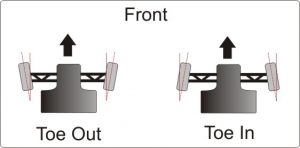

Posted: July 7, 2016 Read time: 4 Minutes
If you’re serious about racing and looking to get the absolute maximum out of your car on a track/race day, making sure your front wheels are pointing in the right direction would seem like an obvious thing to do.
But the right direction doesn’t necessarily mean the same direction and in this short post we’ll be looking at why you might not want to have your front wheels perfectly facing forward.
In perfectly neutral conditions, cars are more stable in a straight line when the wheels are pointing in the same direction. It’s not only good for stability, it also minimises tyre wear and maximises the conversion of raw power into forward motion. Neutral conditions however, are rare. Cars are constantly accelerating, decelerating and cornering whilst going up and down hills and encountering all manner of obstacles and surface types. That’s not really a big deal in an ordinary road car. Unless you’re one of the stars that have unwittingly appeared on “Police, Camera Action” in recent years, it’s unlikely you’ll be taking a road car to the limit of its capabilities. If you’re a racer or a serious track day enthusiast, however, you just might… and in those situations, you might choose to be ‘toe in’ or ‘toe out’.
Contrary to how it sounds, the two options are not an indication of whether you hang your feet inside or outside of the car as you drive around the circuit. Toe in, as you’ll see below - is when both of the front wheels are pointing inwards whilst Toe out is… you guessed it - the complete opposite.
So why would you choose to opt for either of these set-ups if they’re going to increase tyre wear and reduce the effectiveness of power delivery? The answer lies in directional stability.
By opting for a ‘toe in’ set-up - under normal, perfectly flat conditions the wheels would point inwards and the car would drive forwards, albeit a little less efficiently than normal. Minor disturbances in the road however, are likely to pull the wheels rearward about the steering axis… effectively straightening their line. What this means then, is that unless you’re driving on a perfectly flat and perfectly smooth surface, having an angle of ‘toe in’ will ensure your car better absorbs irregularities in the track surface in a straight line when your car is at high speeds.
On the contrary, a ‘toe-out’ set-up will initiate or accentuate a turn when there are disturbances in the road. This can make it very unstable and ‘twitchy’ in straight lines and is not recommended for road cars, but it does make it extra sharp when turning into corners and that’s good for serious racers on lower speed, high cornering circuits or ovals. Adding a small amount of toe-out is also something to consider if you’re racing a front wheel drive car with high levels of understeer.
Of course, there are 4 wheels on a car and providing your car has independent suspension (which most do), you might also want to consider your toe set-up for the rear of the vehicle but be careful as this is far more sensitive. With a toe-out set-up inducing so much instability on the straights, it’s common to counter this with a toe-in set up on the back to help keep the car under control.
The optimum toe setting will be an ever-changing and never quite achievable target determined by your choice of car, choice of track and track conditions, but hopefully, this brief introduction will give you the inclination to learn a little bit more.
As one of the UK's leading driver training companies, CAT Driver Training has extensive experience supporting the motor industry, road, track & race drivers across the globe. If you would like to learn more about how we can help you reach your driving objectives (regardless of current level) contact us today on 01234 757 633.
Call: 01234 757 633
Email: info@catdrivertraining.co.uk
CAT Driver Training is the fast way to develop & improve authentic dynamic driving skill, technique & knowledge from the Best. OEM recognised driver training for individuals & the motor industry. As the leading UK based independent advanced performance driving skills company, we exist to make your driving experience even better. Explore your cars potential, fulfill your own. Coaching advanced road & track skills, safety driver training courses for individual driving enthusiasts & advanced driving for all facets of the motor industry. The only training company resident within UTAC's Millbrook Proving Ground in Bedfordshire, within easy reach of London, & all surrounding counties: Hertfordshire; Buckinghamshire; Oxfordshire; Nottinghamshire; Cambridgeshire; Norfolk; Suffolk; Essex; & Surrey. Clients travel from the World over & the UK to learn from the authentic evidence based dynamic driving & vehicle dynamic experts. | All Rights Reserved | Copyright 2005 – 2024
Some of the links we use are affiliate links. This means that, at no cost to you, CAT will earn an affiliate commission if you click through the link and finalise a purchase.
Designed by WHP
Coded and built by Prominent Media